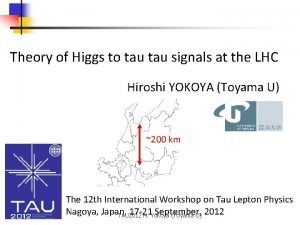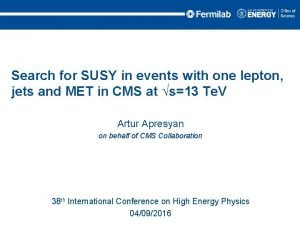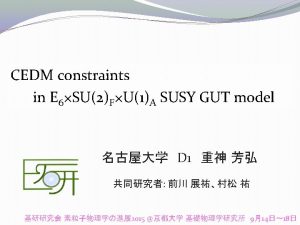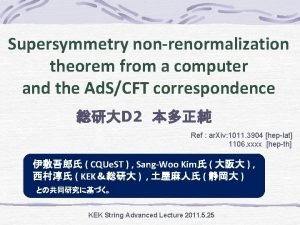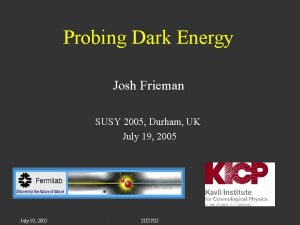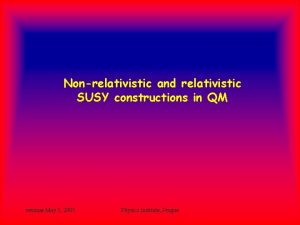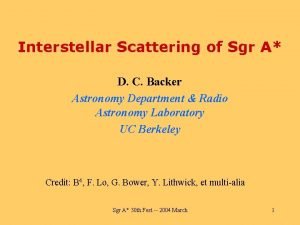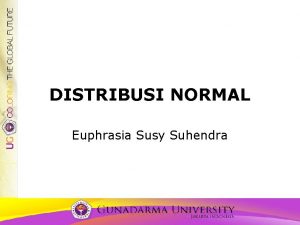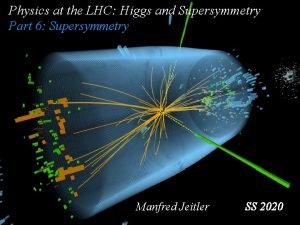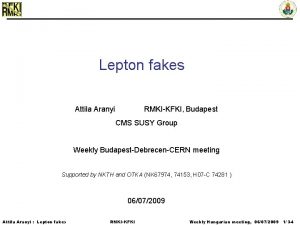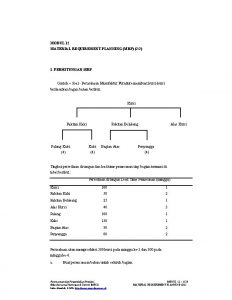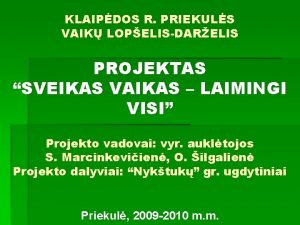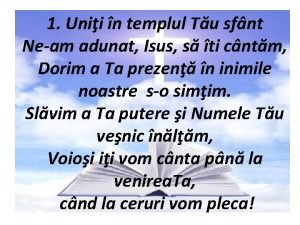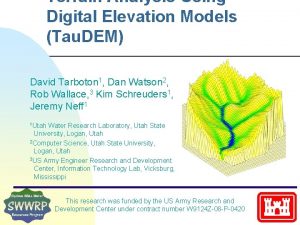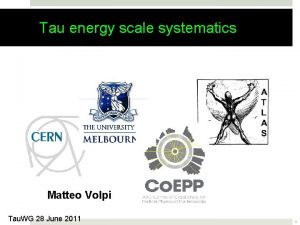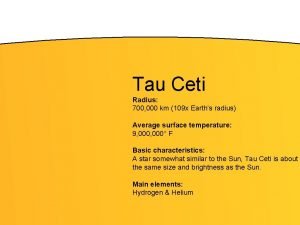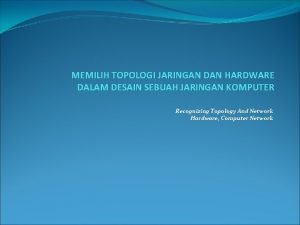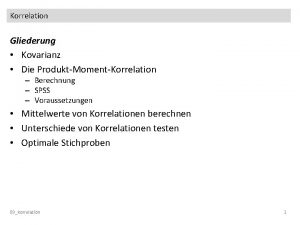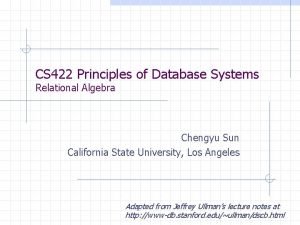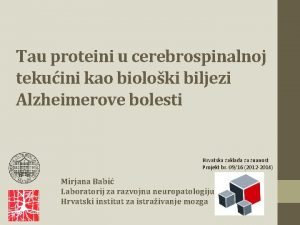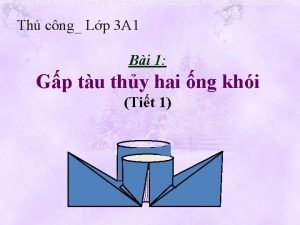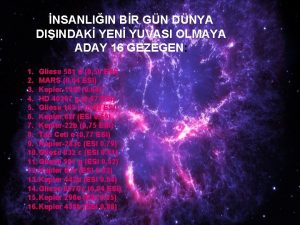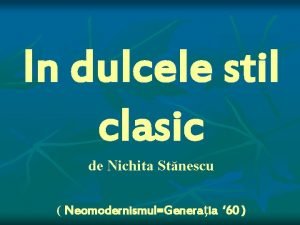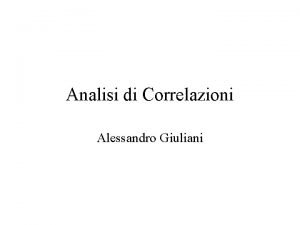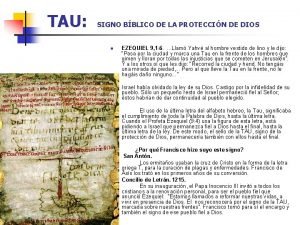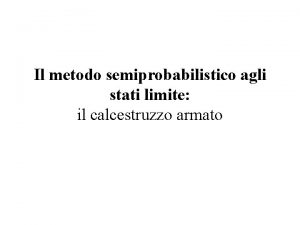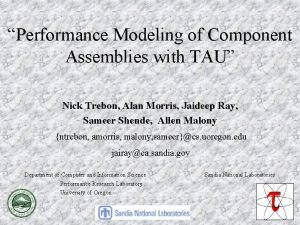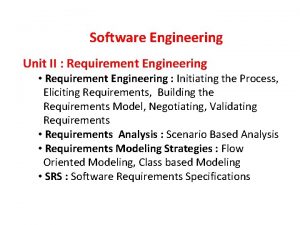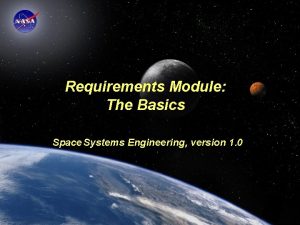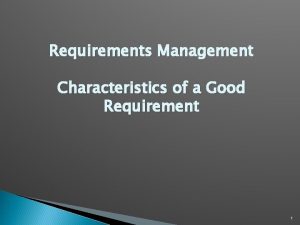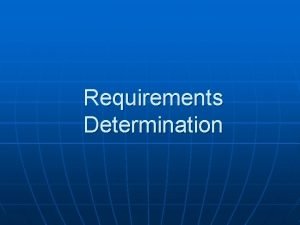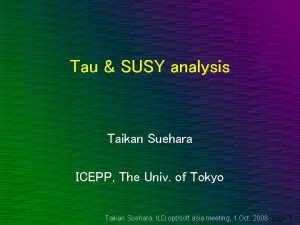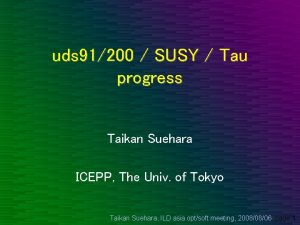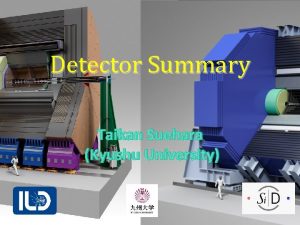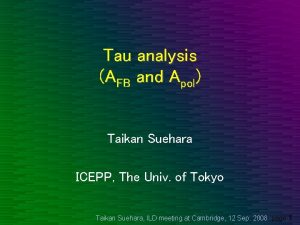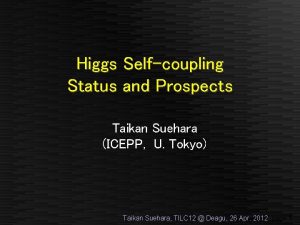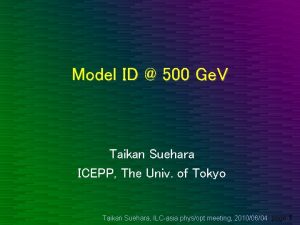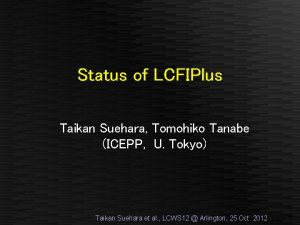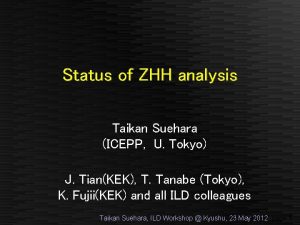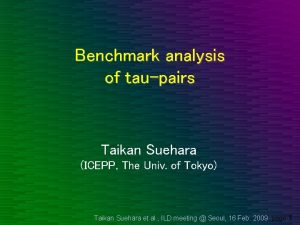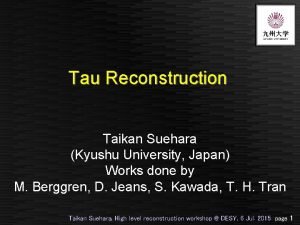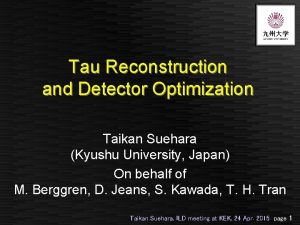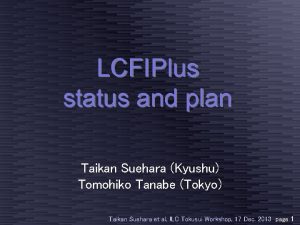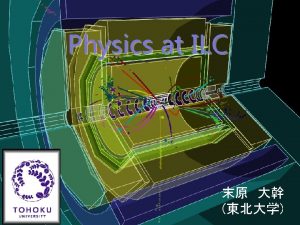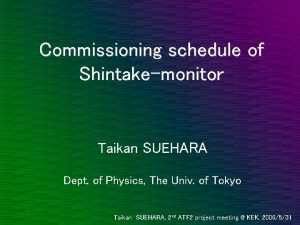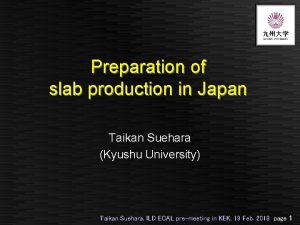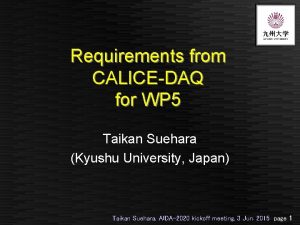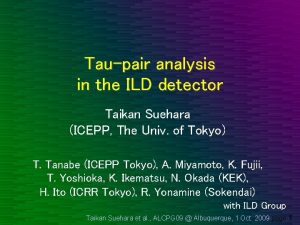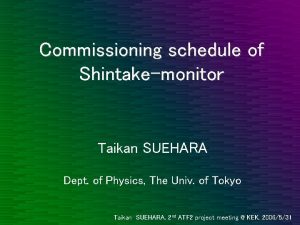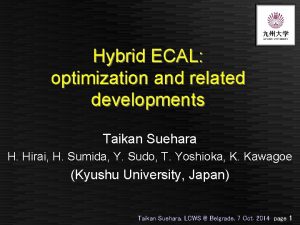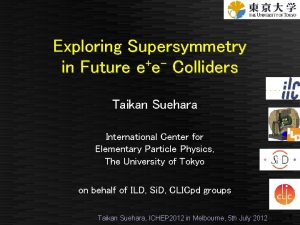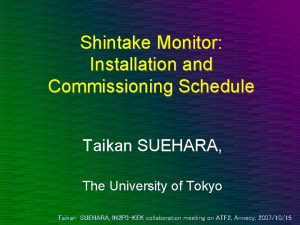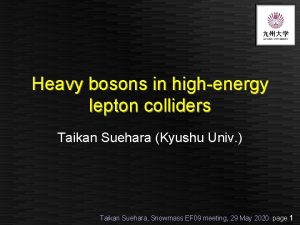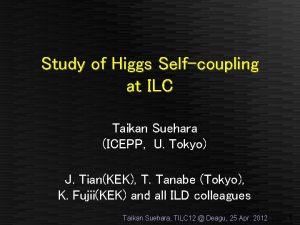Tau SUSY plan data requirement Taikan Suehara ICEPP










































































- Slides: 74

Tau & SUSY plan & data requirement Taikan Suehara ICEPP, The Univ. of Tokyo Taikan Suehara, ILD optimization meeting, 1 Oct. 2008 page 1

Tau-pair status & plan • AFB and P(t) analysis has been done. • Background should be not be critical – Study with more statistics should be needed. – All SM process scan (using LDC’ data) is in preparation. • 100 files processed successfully by 1 CPU, 3 hours on GRID. • P(t) of pn and rn (w. r/p 0 reco) studied. – – Difference on beam pol. is observed. Absolute value does not fit well, need more study. Need more statistics (because selection eff. is low). Other P(t) calc methods for rn mode should be investigated. – Currently no study for a 1/lepton mode. Taikan Suehara, ILD optimization meeting, 1 Oct. 2008 page 2

Required number of events(1) • Tau-pair signal – 2. 6 pb (e. L), 2. 0 pb (e. R) – br x eff. : ~ 2% for both pn and rn mode • 40 -50 events / fb-1 – 500 fb-1 is needed for ~1% P(t) error. – 2. 3 M events for 500 fb-1 – possible to process? – Back to back preselection can reduce to about a half (~ 1 M for 500 fb-1) Current analysis uses ~ 40 fb-1 Taikan Suehara, ILD optimization meeting, 1 Oct. 2008 page 3

Required number of events (2) • Bhabha – 34000 pb without preselection – 50 pb after current preselection – 1 M events for 10 fb-1 • Back to back (opening angle < 175 deg) • |cos(q)| < 0. 92 – Further preselection is needed for 500 fb-1 process • Visible energy (< 450 Ge. V etc. ) might be usable. – e/p separation needs the full simulation. • gg-tt – ~1 pb after current preselection (same as bhabha) – 500 fb-1 is possible (500 k events) • Other modes will be investigated by full SM scan. Taikan Suehara, ILD optimization meeting, 1 Oct. 2008 page 4

SUSY-jet status & plan • SM 4 jet (mainly WW) separation and chargino/neutralino separation has been done. – Efficient separation is possible. • SUSY mass fit has been tried. – Fitting error is about 1 Ge. V range. – Systematic shift (several Ge. V) is observed. • Plan – – – Compare with LDC’ (can be done within days) Full SM background scan (after tau) Suppress systematic shift of mass fit Incorporate with DESY – kinematical fit etc. Flavor/ W charge tag for production angle measurement. Taikan Suehara, ILD optimization meeting, 1 Oct. 2008 page 5

Required number of events • SUSY chargino/neutralino point 5 – < 100 k events for 500 fb-1: no problem • SM 4 jet: 10 pb-1 – 50 fb-1 should be produced for standard samples. – Preselection of visible energy should be effective – need to study. • SM 4 jet + neutrino: 30 fb-1 – 15 k events for 500 fb-1: no problem • Other mode will be checked by full SM scan. Taikan Suehara, ILD optimization meeting, 1 Oct. 2008 page 6

Data requirements summary • Tau-pair – Signal: 2. 3 M (full 500 fb-1) or 1 M (selected 500 fb-1) – Bhabha: 1 M (selected 10 fb-1) or further selection – ggtt: ~100 k (selected 500 fb-1) – Other: should be checked by full SM scan • SUSY-jet – Signal: 100 k (full 500 fb-1) – 4 jet: ? ? – 4 jet+neutrino: 15 k (full 500 fb-1) – Other: should be checked by full SM scan Taikan Suehara, ILD optimization meeting, 1 Oct. 2008 page 7

Additional comments: New jet clustering • Target – Improve 4/6 jet clustering (tt / SUSY jet) – Include isolated lepton tagging • Concept (preliminary) – – – Isolated leptons (inc. taus) are tagged and removed Secondary vertex search – used as jet core Angular clustering rather than ycut # of jets: free or semi-fixed (min-max) or fixed (optional) # of expected b/c jets as user input • Schedule – First version before LCWS (hopefully). Taikan Suehara, ILD optimization meeting, 1 Oct. 2008 page 8

Thank you. Taikan Suehara, ILD optimization meeting, 1 Oct. 2008 page 9

Backup Cambridge talks: Tau-pair SUSY jet and smuon Taikan Suehara, ILD optimization meeting, 1 Oct. 2008 page 10

Tau analysis (AFB and Apol) Taikan Suehara ICEPP, The Univ. of Tokyo Taikan Suehara, ILD optimization meeting, 1 Oct. 2008 page 11

Physics process for optimization Benchmark processes: Processes (e+e- ) √S (Ge. V) Observables Comments ZH, ZH e+e-X, 250 s, m. H=120 Ge. V, test materials and g. ID m-m+X 250 s, m. H=120 Ge. V, test DP/P ZH, H cc, Z nn 250 Br(H cc) Test heavy flavour tagging and antitagging of light quarks and gluon , Z qq 250 Br(H qq) Same as above in multi-jet env. Z* t+t- 500 s, AFB, Pol(t) Test p 0 reconstruction and t rec. aspects of PFA tt, t b. W, W qq’ 500 s, AFB, mtop Test b-tagging and PFA in multi-jet events. mtop=175 Ge. V c + c - , c 20 500 s, mc Point 5 of Table 1 of BP report. W/Z separation by PFA Taikan Suehara, ILD optimization meeting, 1 Oct. 2008 page 12

Tau-pair issues • PFA performance in high-g (140) ts – 1 or 3 energetic emp + 0 -several p 0 s (rarely Ks) – Concentrated in narrow angles, not easy to separate in PFA • Cross section and AFB meas. – Background suppression • Bhabha & gg -> tt • Polarization measurements – Decay mode identification • Mode separation cuts • Invariant mass cuts of r/p 0 in rn mode – Obtaining Apol by angular dist. of decay products Taikan Suehara, ILD optimization meeting, 1 Oct. 2008 page 13

Event samples (sig. & bg. ) • Signal cross sections: 2. 6 pb (e. L), 2. 0 pb (e. R) • Simulated events: – ~80 fb-1 in GLD, GLD’ and J 4 LDC with Jupiter – ~80 fb-1 in LDC’ with Mokka – Reconstructed by Marlin. Reco/Pandora. PFA (ilcsoft v 01 -04) • Backgrounds: – Bhabha (35000 pb) • 50 pb preselected: |cosq| < 0. 92, jet angle < 170 deg • 0. 2 fb-1 in GLD’ with Jupiter • Good ep separation is essential – gg -> tt (1500 pb) • Separation cut by generator info. • Cut by angular & energy information Taikan Suehara, ILD optimization meeting, 1 Oct. 2008 page 14

BG suppression cuts 1. Specialized jet clustering (Ta. Jet) – Njet=2 durham is not worked due to ISR/FSR 2. 1 positive & 1 negative jets required 3. Opening angle > 170 deg 4. |cos(theta)| < 0. 9 for both jets – Bhabha is much larger in the edge region 5. Number of track <= 6 – Veto hadronic events 6. 2 -electron and 2 -muon veto – – For bhabha and ee->mm veto E-ID by Ecal/total deposit, m-ID by hit/track energy 7. Visible energy > 40 Ge. V – gg->tt rejection Taikan Suehara, ILD optimization meeting, 1 Oct. 2008 page 15

BG suppression cuts results • Backgrounds are suppressed to negligible level. • Signal efficiency is ~23%, quite low but… – Most cut events in first 2 cuts are with hard-photons – Practical signal efficiency is considered ~75% Taikan Suehara, ILD optimization meeting, 1 Oct. 2008 page 16

Tau AFB result SM calculation (Red: left, Blue: right) No difference between geometries Taikan Suehara, ILD optimization meeting, 1 Oct. 2008 page 17

Decay modes in Apol analysis t -> enn • Branching ratio: 17. 8% • 3 body decay; pol. info is smeared t -> mnn • Branching ratio: 17. 4% • 3 body decay; same as enn mode t -> pn • Branching ratio: 10. 9% • Pol. can be directly observed by p distribution t -> rn, r -> pp • Branching ratio: 25. 2% • Pol. of r can also be obtained by p distribution in r-rest frame (pol. of r is connected to pol. of t) t -> a 1 n, a 1 -> ppp • Branching ratio: 9. 3% • Currently not used because statistics is low Taikan Suehara, ILD optimization meeting, 1 Oct. 2008 page 18

Analysis flow Apol analysis highlights: • Mode selection • Invariant masses of r and p 0 • Apol calculation by angular distribution of ps Pandora PFA PFO particles Ta. Jet jet finder Jets 1+1 jets cut Back to back cut BG veto cuts 1 prong cut Lepton veto Energy cut AFB Neutral particle No Apol (t->pn) r reconstruction Yes p 0 reconstruction Apol Taikan Suehara, ILD optimization meeting, Oct. 2008 (t 1 -> rn) page 19

t -> pn selection cuts 1. 1 prong cut Jets with >2 charged particle rejected. 2. Lepton veto Events containing e/ms are rejected. (criteria is the same as AFB lepton-pair veto) 3. Energy cut Jets with energy < 10 Ge. V rejected. (e/m/p separation is inefficient in low energy) 4. Events with > 1 Ge. V neutral particles are rejected. In “tight cut” event with any neutrals are rejected. Taikan Suehara, ILD optimization meeting, 1 Oct. 2008 page 20

t -> pn selection results Selection performance between geometries (look at the 2 nd row from the bottom) • Efficiency: not so different • Purity: LDC’ > GLD’ > J 4 LDC – t -> rn mode (decay 2 p is mis-reconstructed as single) might be the reason (larger is better) – LDC’ has advantage due to high CAL granularity. Taikan Suehara, ILD optimization meeting, 1 Oct. 2008 page 21

Apol calculation (pn mode) Statistical error is almost the same for all geometries Value shifts are larger in GLD’/J 4 LDC due to the lower purity. Stat error in 500 fb-1 Values obtained by signal-only events! Value shift due to the mode BG Taikan Suehara, ILD optimization meeting, 1 Oct. 2008 page 22

t -> rn selection cuts 1. 1 prong cut 2. Lepton veto 3. Energy cut (jet energy must be > 10 Ge. V) Above are same as t->pn cuts 4. Events with > 10 Ge. V from neutrals (in total) are selected. 5. Mass of r is reconstructed, must be within 200 Me. V from actual mass (770 Me. V). 6. Mass of p 0 is reconstructed with neutral particles. If # of neutrals >=3, nearest (in angle) two are combined until 2 particles are left. Application of this cut is discussed later. Taikan Suehara, ILD optimization meeting, 1 Oct. 2008 page 23

r and 0 p reconstruction • Clear difference observed in invariant mass distributions. – LDC’s best, larger is better in Jupiter geometries. – Mark confirmed the granularity affects the mass distributions. • Three candidates in rn mode selection – No p 0 mass cut, p 0 cut with left edge included / excluded Taikan Suehara, ILD optimization meeting, 1 Oct. 2008 page 24

r -> pn selection results • 3 rd row from bottom: used as “no p 0 mass cut”. • 2 nd row from bottom: used as “p 0 mass cut”. – Events with single neutral are survived with this cut. • Most bottom row: used as “tight p 0 mass cut”. – Events with single neutral are eliminated with this cut. • Clear difference by geometries: LDC’s the best, bigger is better in Jupiter’s. Taikan Suehara, ILD optimization meeting, 1 Oct. 2008 page 25

t -> rn, r->pp distribution (1) no p 0 cut Ppol vs dist. calc • Clear difference between e. L and e. R observed. • Distribution is degraded due to the cut effects. Taikan Suehara, ILD optimization meeting, 1 Oct. 2008 page 26

t -> rn, r->pp distribution (2) tight p 0 cut • Number of signal is about a half. • Difference between geometry enhanced. – J 4 LDC is not realistic with this cut? • Background is quite low, negligible level. Taikan Suehara, ILD optimization meeting, 1 Oct. 2008 page 27

Obtaining P(t) value Physics Letters B, 235 (1990) 198 • Combined information of t -> rn and r -> pp decay can be used in this method. Taikan Suehara, ILD optimization meeting, 1 Oct. 2008 page 28

Apol calculation (rn mode) Statistical errors are larger in GLD’/LDC, esp. with mp 0 cut. Value shift is smaller than pn mode, negligible with mp 0 cut. Stat error in 500 fb-1 Values obtained by signal-only events! Value shift due to the mode BG Taikan Suehara, ILD optimization meeting, 1 Oct. 2008 page 29

Performance Summary Geometry GLD’ J 4 LDC LDC’ Related to AFB ○ ○ BG cut Apol(pn, stat) ○ ○ Selection efficiency Apol(pn, shift) ○ △ × ◎ Selection purity Apol(rn, stat) ○ △ × ◎ Selection efficiency Apol(rn, shift) ○ ○ Selection purity Overall ○ △ × ◎ • Difference comes from r/p 0 reconstruction – Shift of pn comes from r with missing photon. – Stat error of rn comes from worse r/p 0 reconstruction. • Larger/higher granularity geometry preferred. • But anyway the difference might be not critical… Taikan Suehara, ILD optimization meeting, 1 Oct. 2008 page 30

Comments • AFB calculation includes no backgrounds. – All backgrounds can be suppressed to <10% of signal in generator level. – Accidental (on-flight decay, etc. ) background is very difficult to estimate. • For Apol study statistics is not sufficient. • Obtained Apol is deviated from expectation: need to check systematic effects further. • Performance should be checked on highgranualized GLD-size detector (might be optimal). Taikan Suehara, ILD optimization meeting, 1 Oct. 2008 page 31

Thank you for your attention. Taikan Suehara, ILD optimization meeting, 1 Oct. 2008 page 32

Backup Taikan Suehara, ILD optimization meeting, 1 Oct. 2008 page 33

Opening angle cut Taikan Suehara, ILD optimization meeting, 1 Oct. 2008 page 34

Costheta cut Taikan Suehara, ILD optimization meeting, 1 Oct. 2008 page 35

Visible energy cut Taikan Suehara, ILD optimization meeting, 1 Oct. 2008 page 36

SUSY analysis (smuon and chargino/neutralino 4 -jet) Taikan Suehara ICEPP, The Univ. of Tokyo Taikan Suehara, ILD optimization meeting, 1 Oct. 2008 page 37

Topics • Overview • Smuon analysis (very quick analysis) – Event characteristics – Result of mass determination • Chargino/neutralino 4 -jet analysis – Event characteristics – Background suppression (SM 4 -jets) – Chargino/neutralino separation by W/Z mass – Result of mass determination • Performance of each geometry Taikan Suehara, ILD optimization meeting, 1 Oct. 2008 page 38

Overview Taikan Suehara, ILD optimization meeting, 1 Oct. 2008 page 39

Physics process for optimization Benchmark processes: Processes (e+e- ) √S (Ge. V) Observables Comments ZH, ZH e+e-X, 250 s, m. H=120 Ge. V, test materials and g. ID m-m+X 250 s, m. H=120 Ge. V, test DP/P ZH, H cc, Z nn 250 Br(H cc) Test heavy flavour tagging and antitagging of light quarks and gluon , Z qq 250 Br(H qq) Same as above in multi-jet env. Z* t+t- 500 s, AFB, Pol(t) Test p 0 reconstruction and t rec. aspects of PFA tt, t b. W, W qq’ 500 s, AFB, mtop Test b-tagging and PFA in multi-jet events. mtop=175 Ge. V c + c - , c 20 500 s, mc Point 5 of Table 1 of BP report. W/Z separation by PFA Taikan Suehara, ILD optimization meeting, 1 Oct. 2008 page 40

SUSY parameters Analyzed processes: Smuon – point 1 Chargino/neutralino – point 5 Taikan Suehara, ILD optimization meeting, 1 Oct. 2008 page 41

Event topology • • • Similar for all processes in this talk Visible W/Z/m pair + missing LSP pair 2 -body decay – monochromatic in decay frame Nearly flat distribution with sharp edges in lab. frame Edge positions can be translated to SUSY masses – Energy resolution at edges is essentially important • Generator distributions Muon energies in smuon events Ws in charginos Zs in second neutrinos Taikan Suehara, ILD optimization meeting, 1 Oct. 2008 page 42

Smuon mode Taikan Suehara, ILD optimization meeting, 1 Oct. 2008 page 43

Smuon-pair overview • Events – Smuon mass: 122. 98 Ge. V – LSP mass: 97. 44 Ge. V – Cross sections: 28. 53 fb (e. L), 121. 56 fb (e. R) – GLD, GLD’ and J 4 LDC each 500 fb-1 – SM nnmm sample for BG, Mokka/LDC’, 500 fb-1 • Currently nm sample was only analyzed. • 80 fb in 80% right polarization – No SUSY background, BG separation cuts. • Concerning detector performance – Muon tracking resolution Taikan Suehara, ILD optimization meeting, 1 Oct. 2008 page 44

Energy spectrum of muons • Sharp edges. • No difference between geometries and MC truth. • BG is not critical. • Differential spectra are fitted by Gaussian to obtain SUSY masses. Taikan Suehara, ILD optimization meeting, 1 Oct. 2008 page 45

SUSY mass determination • ~ 200 Me. V mass resolution of smuon/LSP. – Obtained LSP mass can be used for other SUSY modes. • Essentially no difference between 3 geometries. – GLD’ seems slightly worse, but it might be just a statistical effect. Taikan Suehara, ILD optimization meeting, 1 Oct. 2008 page 46

SUSY 4 -jet-mode Taikan Suehara, ILD optimization meeting, 1 Oct. 2008 page 47

Chargino/neutralino 2 4 -jet mode • Events – Chargino/neutralino 2/LSP mass (point 5): 210. 21 / 210. 67 / 117. 36 Ge. V – Cross sections: 157. 61 fb (chargino, e. L), 29. 24 fb (neutralino 2, e. L) • Cross sections in e. R are negligibly small (<1 fb) – GLD, GLD’ and J 4 LDC each 500 fb-1 – 10 fb-1 SM 4 jets (uddu/cssc/udsc) in LDC’ • Total cross section: about 10000 fb (e. L) • Concerning detector performance – Jet energy resolution • To separate W(80. 4 Ge. V) and Z(91. 2 Ge. V) invariant mass • Sharpness of the edge of W/Z energy distribution – Flavor tagging for W/Z separation (not implemented yet) Taikan Suehara, ILD optimization meeting, 1 Oct. 2008 page 48

Analysis flow • Detector simulation (Jupiter(signal) / Mokka(BG)) • Reconstruction (Marlin. Reco & Pandora. PFA) • 4 -jet clustering (Durham. NJet) SM separation cuts • Lepton veto • Jet angle cut • Visible energy cut Chargino / neutralino separation • c 2 cut for W/Z separation • Acoplanarity cut (chargino only) Mass fit W/Z jet association • Using c 2 values of invariant masses • W/Z best candidate is independently chosen • Obtain SUSY masses by energy distribution of W/Z Taikan Suehara, ILD optimization meeting, 1 Oct. 2008 page 49

SM separation cuts • # of SM events becomes comparable to chargino after these cuts. • No difference between geometries in this stage. Taikan Suehara, ILD optimization meeting, 1 Oct. 2008 page 50

W/Z jet association • Select 2+2 jet combination which gives minimum c 2 : c 2 (W) = (m 1 -m. W)2 /sm. W 2 + (m 2 -m. W)2 /sm. W 2 c 2 (Z) = (m 1 -m. Z)2 /sm. Z 2 + (m 2 -m. Z)2 /sm. Z 2 (sm. W = sm. Z = 5 Ge. V) • Peak of W/Z is corrected by shifting every jet energy (0. 9 Ge. V in current analysis) • W/Z separation can be efficiently performed. • No significant difference in W/Z mass peak width. Invariant mass distribution of selected W/Z of chargino/neutralino 2 Taikan Suehara, ILD optimization meeting, 1 Oct. 2008 page 51

2 c distribution / mass cut Events in bottom area are selected as chargino Events in left area are selected as neutralino 2 • c 2 value of 2 W/Z candidates in the event is summed for the criteria. • The cut requires both c 2(W) and c 2(Z) within desired values. Taikan Suehara, ILD optimization meeting, 1 Oct. 2008 page 52

Cut statistics (2) chargino neutralino • BG separation is efficient (see W/Z mass cut rows) • Slightly better BG separation performance in GLD but almost within statistical fluctuations. Taikan Suehara, ILD optimization meeting, 1 Oct. 2008 page 53

Chargino mass fit MC cut and nocut shape is almost the same (wo left edge). No significant difference between geometries can be seen. Taikan Suehara, ILD optimization meeting, 1 Oct. 2008 page 54

Chargino mass fit results • Fitting function: 3 rd polynomial (4 param) (center) / 0 (edge) convoluted with a Gaussian with s as linear function of energy (2 param) edge position: 2 param, total # of parameters = 8 • Cheat fitting: 1. fix edge positions at true value, fit other 6 parameters. 2. fix those 6 parameters and fit edge positions. • No significant difference between geometries. Taikan Suehara, ILD optimization meeting, 1 Oct. 2008 page 55

Neutralino mass fit Distribution in LDC is slightly broader (worse resolution). Chargino background might not be negligible for lower edge. Taikan Suehara, ILD optimization meeting, 1 Oct. 2008 page 56

Neutralino mass fit results • Fitting function: Error function (left) x Complementary error function (right) Width of left and right is the same, # of parameters = 4 • Cheat fitting: Same as chargino • J 4 LDC gives slightly larger width than other two. Corresponding fitting error is enhanced. Taikan Suehara, ILD optimization meeting, 1 Oct. 2008 page 57

Performance Summary Geometry GLD’ J 4 LDC Related to Smuon fit ○ △? ○ Tracking performance Jets selection ◎? ○ ○ W/Z separation Mass fit chargino ○ ○ ○ Jet energy resolution Mass fit neutralino ○ ○ △ Jet energy resolution Overall ○ ○ △? • Performance is almost identical. • Slight hint of worse energy resolution in J 4 LDC. – Might be corresponding to PFA performance. • Difference of smuon fit and W/Z separation might be random effect. Taikan Suehara, ILD optimization meeting, 1 Oct. 2008 page 58

Comments • Mass fit of chargino/neutralino is problematic: practically we might need a kind of “template fit” for accurate estimation. – Templates of various SUSY masses are needed for the template fit. • Mass cut of W/Z might be too tight. We can earn efficiency by looser mass cuts. – Need to be optimized. • LDC’ SUSY events can be analyzed in the same framework, can be checked in a week. Taikan Suehara, ILD optimization meeting, 1 Oct. 2008 page 59

Thank you for your attention again! Taikan Suehara, ILD optimization meeting, 1 Oct. 2008 page 60

Backup Taikan Suehara, ILD optimization meeting, 1 Oct. 2008 page 61

Cuts(1) 1. Jet clustering (njet=4) 2. Lepton ID/veto – – 3. 4. 5. 6. Electron by Ecal/total deposit >0. 9 or tagged by Pandora. PFA Muon by calo/track energy < 0. 5 Currently no tau-ID Events with >20 Ge. V leptons are cut |Cos(theta)|<0. 9 for all jets E>5 Ge. V for all jets Visible energy < 300 Ge. V Combining W/Z using remaining events Taikan Suehara, ILD optimization meeting, 1 Oct. 2008 page 62

Lepton veto Taikan Suehara, ILD optimization meeting, 1 Oct. 2008 page 63

Jet angle cut Taikan Suehara, ILD optimization meeting, 1 Oct. 2008 page 64

Visible energy cut Loose cut (300 Ge. V) is for accepting lighter SUSY particles (LSP to 100 Ge. V) Taikan Suehara, ILD optimization meeting, 1 Oct. 2008 page 65

W/Z mass peak – all combination Cut condition – 4 jet clustering – Lepton veto (<20 Ge. V) – All jet angle < 0. 6 (Barrel only) – No Evis cut – No Ejet cut – All combination • Energy peak is shifted – need correction • All jet energy is shifted (0. 8 Ge. V) to fit the peak • No difference between geometries again Taikan Suehara, ILD optimization meeting, 1 Oct. 2008 page 66

Cuts(2) 7. Select best-W and best-Z combination by c 2 (W) = (m 1 -m. W)2 + (m 2 -m. W)2 c 2 (Z) = (m 1 -m. Z)2 + (m 2 -m. Z)2 Minimum c 2 (W) pair is selected for W analysis and minimum c 2 (Z) pair is selected for Z analysis. 1 s width of W and Z mass resolution is 5 Ge. V for both. 8. Angular cut of best-combined W/Z |cos(theta_Wor. Z)| < 0. 8 9. Acoplanarity cut >10 deg for chargino, no cut for neutralino 10. Mass cut using c 2 values Chargino cut: c 2(W) < 2 and c 2(Z) > 4 Neutralino cut: c 2(Z) < 2 and c 2(W) > 4 Taikan Suehara, ILD optimization meeting, 1 Oct. 2008 page 67

W/Z angular cut W angular distribution is shown (Z is similar). Taikan Suehara, ILD optimization meeting, 1 Oct. 2008 page 68

Acoplanarity cut This cut is for chargino only. SM is plotted without Evis and W/Z angular cut Taikan Suehara, ILD optimization meeting, 1 Oct. 2008 page 69

Result of mass fit • Input and fitted masses are largely deviated – Need to check the reasons – Previous fitting gave better consistency • Jet energy correction is revised: using MC jet energy -> using W/Z peak • Various cuts are changed, mass cut is looser in previous analyses • Chargino higher edge has poor resolution • LDC has larger width in neutralino fitting Taikan Suehara, ILD optimization meeting, 1 Oct. 2008 page 70

Muon track – reco - MC • No difference (RMS ~ 200 Me. V). Taikan Suehara, ILD optimization meeting, 1 Oct. 2008 page 71

Chargino mass fit (wo. MC) Taikan Suehara, ILD optimization meeting, 1 Oct. 2008 page 72

Chargino MC vs Reco Mass cut by 80 Ge. V W Slightly shifted? Taikan Suehara, ILD optimization meeting, 1 Oct. 2008 page 73

Chargino MC cut vs nocut Very slight shift (left edge? ) Taikan Suehara, ILD optimization meeting, 1 Oct. 2008 page 74
 Higgs to tau tau
Higgs to tau tau Contoh requirement
Contoh requirement Susy clemens
Susy clemens Mark twain father
Mark twain father Susy
Susy Whom do lennie and george agree to let live on their farm?
Whom do lennie and george agree to let live on their farm? Susy dala
Susy dala Susy dala
Susy dala Susy model
Susy model Susy isn't a normal maid
Susy isn't a normal maid Susy qm
Susy qm Susy shear
Susy shear Susy klein
Susy klein Susy backer
Susy backer Pt gs mengklaim rata rata berat buah mangga
Pt gs mengklaim rata rata berat buah mangga Supersymmetry
Supersymmetry Fake?
Fake? Business concept presentation
Business concept presentation Personnel requirement in business plan
Personnel requirement in business plan Material requirement plan
Material requirement plan Requirement analysis model in software engineering
Requirement analysis model in software engineering Apa itu data requirement gathering
Apa itu data requirement gathering Karakia whakamutunga
Karakia whakamutunga Karakia whakamutunga kia tau
Karakia whakamutunga kia tau Elastisk tau biltema
Elastisk tau biltema Labas rytas tau galvyte
Labas rytas tau galvyte Uniti in templul tau sfant versuri
Uniti in templul tau sfant versuri Tetrathlon gun
Tetrathlon gun Taudem
Taudem Tau energi
Tau energi Tau ceti distance to earth
Tau ceti distance to earth Bagaimana cara memilih topologi jaringan yang tepat?
Bagaimana cara memilih topologi jaringan yang tepat? Tetrachorische korrelation
Tetrachorische korrelation Sigma minusculo
Sigma minusculo Delta relational algebra
Delta relational algebra Letra tav
Letra tav Delta tau alpha honor society
Delta tau alpha honor society Tau proteini
Tau proteini Tau beta sigma flag
Tau beta sigma flag Malanga fakaosi tau
Malanga fakaosi tau Traje de anubis
Traje de anubis Tizen advanced ui
Tizen advanced ui Gấp tàu thủy hai ống khói
Gấp tàu thủy hai ống khói Sen tau
Sen tau Tau ceti e
Tau ceti e Trasaturile neomodernismului
Trasaturile neomodernismului Perurima leyenda
Perurima leyenda Tau tangles
Tau tangles Kendall's tau formula
Kendall's tau formula Upper ngau tau kok estate
Upper ngau tau kok estate Tuia te here tangata karakia
Tuia te here tangata karakia Ayat alquran tentang kematian
Ayat alquran tentang kematian Tau signo
Tau signo Mama mamyte as tave myliu
Mama mamyte as tave myliu Vinkelsurrning
Vinkelsurrning Tau ammissibile
Tau ammissibile Proxy tau
Proxy tau Tau vs titans
Tau vs titans Tàu caraven
Tàu caraven What is gross working capital
What is gross working capital Reserve requirement ratio
Reserve requirement ratio Maintenance requirement example
Maintenance requirement example System requirements specification
System requirements specification What is data flow diagram in software engineering
What is data flow diagram in software engineering Requirement specification process
Requirement specification process Bona fide occupational qualification
Bona fide occupational qualification Maximum material condition
Maximum material condition Ms 1722 standard requirement
Ms 1722 standard requirement Field grade oer examples
Field grade oer examples What is a derived requirement
What is a derived requirement Qualities of a good requirement
Qualities of a good requirement Requirement validation in software engineering
Requirement validation in software engineering Requirements engineering
Requirements engineering Requirement determination
Requirement determination Requirement analysis diagram
Requirement analysis diagram
